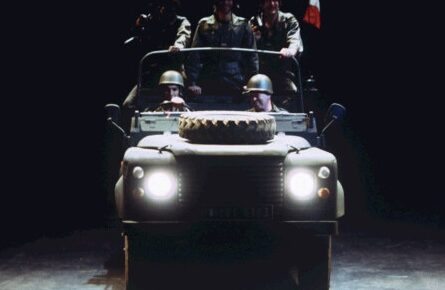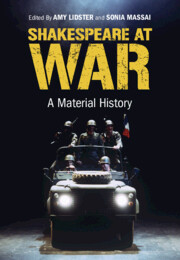
When Russian forces invaded Ukraine in March 2022, Shakespeare’s Hamlet was repeatedly used by theatre makers, scholars, and political leaders to express the existential threat faced by Ukrainians and to provoke debate about Western involvement in the crisis. President Volodymyr Zelenskyy claimed, in an address to the British parliament on 8 March, that ‘the question for us now is “to be or not to be”’. His answer to that question was ‘definitely yes, “to be”’.[1] Shortly after, the Ivan Franko National Academic Drama Theatre performed Hamlet in a bomb shelter and dedicated the production to ‘the people of the UK for ongoing support of Ukraine & in recognition of the Blitz of WW2 in which the UK’s civilian population was also bombed’.[2] At the same time, Nataliya Torkut, Head of the Ukrainian Shakespeare Centre, resolutely asserted that ‘Ukraine has chosen “to be” – to be an independent country, a democracy, a part of Europe’.[3] These uses of Hamlet tap into a history of oppositional readings of Shakespeare in Ukraine, while also showing that the dramatist and his works continue to be pressingly relevant at times of war.
Over the past four hundred years, Shakespeare has been ‘recruited’ more than any other Anglophone writer during wartime. Laurence Olivier’s famous 1944 cinematic adaptation of Henry V may be one of the most familiar examples, but what is often overlooked is how embedded Shakespeare has become during conflict, especially in those with British involvement. For centuries, he has been used to bolster or to critique the reasons for going to war; to motivate soldiers to cross enemy lines and risk their lives on a battlefield; and to help soldiers, prisoners of war, and civilians to process the experience of being at war. These uses not only involve performances of the plays – which occasionally took place just behind the frontline – but also through Shakespearean quotations, caricatures, political speeches, and the plays as wartime reading material.
We embarked on this project fully aware of the fact that, while the topic of ‘war’ in Shakespeare has been explored before, there was no comprehensive, cross-period history of how Shakespeare has been used at times of war. We aimed to cast a spotlight on material objects – on photographs, watercolours, letters, posters, and cartoons as well as theatre programmes, props, and cue scripts – that reveal quite unexpected evidence and diverse stories of ‘wartime Shakespeare’, spanning the eighteenth to the twenty-first centuries. We also wanted to bring together an interdisciplinary range of expertise, and our contributors to Shakespeare at War: A Material History include Shakespeare scholars, social theorists, historians, theatre directors, and public military figures. The collection offers the first interdisciplinary material history of Shakespeare at times of conflict. Each contributor takes an object as their jumping off point to ask broader questions about how Shakespeare has been used during a specific context and crisis. These stories collectively suggest pervasive use and nuanced reception of his works quite beyond what we had expected.
Our collection is also linked to a free public exhibition that we curated at the National Army Museum, London, which runs from October 2023 to April 2024. Some of the objects featured within the collection also appear in the exhibition, alongside many other items that expand upon these diverse histories of Shakespeare at war. Featured both in the collection and the exhibition, George M. Woodward’s ‘Buonaparte’s Soliloquy at Calais’ (1803) offers a caricature of Napoleon and a full-length parody of Hamlet’s famous speech ‘To be or not to be’, which is rewritten for the French leader who debates the merits of invading Britain: ‘To go or not to go, that is the question’, while the rub for Napoleon is the risk of defeat. It is an example of anti-French propaganda at a time when the threat of an invasion on Britain’s shores was high. The parody also circulated more widely, reaching German readers through the Weimar journal London und Paris, where it appeared in both English and German. This example reveals how readers across state and conflict lines used Shakespeare to understand and comment on the unfolding global crisis.
Politicians, propagandists, and governments have often recognized the value in ‘recruiting’ Shakespeare, using, for example, quotations from his plays in enlistment posters. A 1915 Parliamentary Recruitment Committee poster reads ‘Stand not upon the order of your going, but go at once’. Ironically, these words are spoken by Lady Macbeth to dismiss her guests from the banquet after the appearance of Banquo’s ghost, who, invisible to all others, haunts Macbeth, triggering fits of terror in his guilty conscience. Her words acquire a radically different meaning within their new context, but their power is amplified by the recognition factor that attaches to Shakespeare.
Many private individuals – including soldiers, civilians, and prisoners – have also chosen Shakespeare to help them understand their experiences of war. During the First World War, prisoners at Ruhleben Internment Camp in Germany staged abridged productions of Shakespeare at their camp theatre, while soldiers on the frontline found solace in the plays as reading material. Private John C. C. Taylor, for example, writing to his employer, London book auctioneer John Hodgson, from ‘about four meters behind the firing line’ somewhere on the Western Front on 6th January 1916, mentions his love for books and how ‘acutely’ he misses them. He then finds solace in discussing how Shakespeare compares to Marlowe. Especially poignant is Taylor’s passing comment that by reading Edward II one appreciates ‘how near [Marlowe] might have approached Shakespeare as a writer of historical plays’; but then again, he adds, ‘Shakespeare matured but poor Marlowe hadn’t time to’.
What did we learn from researching, contributing, and editing the collection? We started this project knowing that Shakespeare has often been invoked during conflict, but we were surprised by how frequently and how extensively Shakespeare has been ‘mobilized’ during wars from the eighteenth to the twenty-first century. Above all, we were surprised by the diversity of Shakespeare’s wartime use – by the wide range of users from different backgrounds and the very different agendas that Shakespeare and his plays have been used to support. What Shakespeare means for us – both then and now – depends on how he is used and read. We believe that the material objects featured within our collection and exhibition – and by the countless more that sit in libraries, museums, and, indeed, within our homes – are vital for recovering these histories. This collection is also an invitation to research further and delve deeper into these pasts.
Image: Parliamentary Recruiting Committee Poster No.52 (London, [1915]). Library of Congress, Prints & Photographs Division, LC-USZC4-10928.

Shakespeare at War by
Amy Lidster and Sonia Massai
Latest Comments
Have your say!